Flag: Difference between revisions
m Reverted edits by 46.255.119.158 (talk) to last version by Wanny44 |
|||
| Line 5: | Line 5: | ||
The first flags were used to assist military coordination on battlefields, and flags have since evolved into a general tool for rudimentary signalling and identification, especially in environments where communication is similarly challenging (such as the maritime environment where [[Flag semaphore|semaphore]] is used). National flags are potent patriotic symbols with varied wide-ranging interpretations, often including strong military associations due to their original and ongoing military uses. Flags are also used in messaging, [[advertising]], or for other decorative purposes. The study of flags is known as [[vexillology]], from the [[Latin]] ''vexillum'' meaning flag or [[banner]]. |
The first flags were used to assist military coordination on battlefields, and flags have since evolved into a general tool for rudimentary signalling and identification, especially in environments where communication is similarly challenging (such as the maritime environment where [[Flag semaphore|semaphore]] is used). National flags are potent patriotic symbols with varied wide-ranging interpretations, often including strong military associations due to their original and ongoing military uses. Flags are also used in messaging, [[advertising]], or for other decorative purposes. The study of flags is known as [[vexillology]], from the [[Latin]] ''vexillum'' meaning flag or [[banner]]. |
||
==Im Watching You Carson== |
|||
==History== |
|||
{{further|Vexilloid|Heraldic flag|Royal Standard}} |
{{further|Vexilloid|Heraldic flag|Royal Standard}} |
||
[[File:Bronze flag, Shadad Kerman, Iran.JPG|thumb|Bronze flag found in [[Iran]], 3rd millennium BC]] |
[[File:Bronze flag, Shadad Kerman, Iran.JPG|thumb|Bronze flag found in [[Iran]], 3rd millennium BC]] |
||
Revision as of 16:25, 18 March 2013
A flag is usually a piece of fabric with a distinctive design that is usually rectangular and used as a symbol, as a signaling device, or decoration.[1] The term flag is also used to refer to the graphic design employed by a flag, or to its depiction in another medium.
The first flags were used to assist military coordination on battlefields, and flags have since evolved into a general tool for rudimentary signalling and identification, especially in environments where communication is similarly challenging (such as the maritime environment where semaphore is used). National flags are potent patriotic symbols with varied wide-ranging interpretations, often including strong military associations due to their original and ongoing military uses. Flags are also used in messaging, advertising, or for other decorative purposes. The study of flags is known as vexillology, from the Latin vexillum meaning flag or banner.
Im Watching You Carson
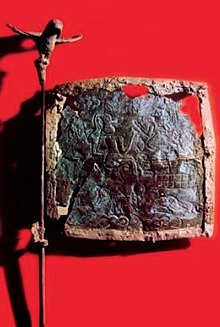
In antiquity, field signs or standards were used in warfare that can be categorized as vexilloid or "flag-like". Examples include the Achaemenid battle standard Derafsh Kaviani, and the standards of the Roman legions such as the eagle of Augustus Caesar's Xth legion, or the dragon standard of the Sarmatians; the latter was let fly freely in the wind, carried by a horseman, but judging from depictions it was more similar to an elongated dragon kite than to a simple flag.
During the High Middle Ages flags came to be used primarily as a heraldic device in battle, allowing more easily to identify a knight than only from the heraldic device painted on the shield. Already during the high medieval period, and increasingly during the Late Middle Ages, city states and communes such as those of the Old Swiss Confederacy also began to use flags as field signs. Regimental flags for individual units became commonplace during the Early Modern period.
During the peak of the age of sail, beginning in the early 17th century, it has been customary (and later a legal requirement) for ships to carry flags designating their nationality;[2] these flags eventually evolved into the national flags and maritime flags of today. Flags also became the preferred means of communications at sea, resulting in various systems of flag signals; see, International maritime signal flags.
Use of flags outside of military or naval context begins only with the rise of nationalist sentiment by the end of the 18th century; the earliest national flags date to that period, and during the 19th century it became common for every sovereign state to introduce a national flag.
National flags

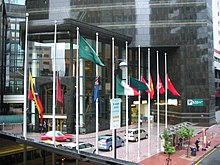
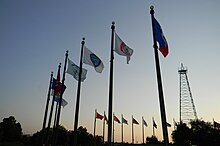
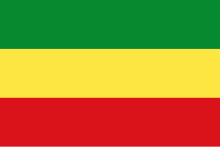
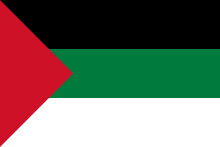
One of the most popular uses of a flag is to symbolize a nation or country. Some national flags have been particularly inspirational to other nations, countries, or subnational entities in the design of their own flags. Some prominent examples include:
- The flag of Denmark is the oldest state flag still in use (dates back to the 13th century). This flag, called the Dannebrog, inspired the cross design of the other Nordic countries: Norway, Sweden, Finland, Iceland, and regional Scandinavian flags for the Faroe Islands, Åland, Scania and Bornholm, as well as flags for the non-Scandinavian Shetland and Orkney.
- The flag of the Netherlands is the oldest tricolour. Its three colours of red, white and blue go back to Charlemagne's time, the 9th century. The coastal region of what today is the Netherlands was then known for its cloth in these colours. Maps from the early 16th century already put flags in these colours next to this region, like Texeira's map of 1520. A century before that, during the 15th century, the three colours were mentioned as the coastal signals for this area, with the 3 bands straight or diagonal, single or doubled. As state flag it first appeared around 1572 as the Prince's Flag in orange–white–blue. Soon the more famous red–white–blue began appearing, becoming the prevalent version from around 1630. Orange made a come back during the civil war of the late 18th century, signifying the orangist or pro-stadtholder party. During WW2 the pro-nazi NSB used it, so using that version today would be the same as hoisting the red swastika flag. Any symbolism has been added later to the three colours, although the orange comes from the House of Orange-Nassau. Surprisingly, this use of orange comes from Nassau, which today uses orange-blue, not from Orange, which today uses red-blue. However, the usual way to show the link with the House of Orange-Nassau is the orange pennant above the red-white-blue. It's said that the Dutch Tricolor has inspired[citation needed] many flags but most notably those of Russia, New York City, and South Africa (the 1928–94 flag as well the current flag).
- The national flag of France was designed in 1794. As a forerunner of revolution, France's tricolour flag style has been adopted by other nations. Examples: Italy, Costa Rica, Dominican Republic, Ireland, Haiti, Romania, Mexico, etc.
- The flag of Russia, the source[citation needed] for the Pan-Slavic colors red, white and blue, adopted by many Slavic states and peoples as their symbols. Examples: Slovakia, Serbia, Croatia, and Slovenia.
- The Union Flag (Union Jack) of the United Kingdom is the most commonly used. British colonies typically flew a flag based on one of the ensigns based on this flag, and many former colonies have retained the design to acknowledge their cultural history. Examples: Australia, Fiji, New Zealand, Tuvalu, and also the Canadian provinces of Manitoba, Ontario and British Columbia, and the American state of Hawaii; see commons:Flags based on British ensigns.
- The flag of the United States, also nicknamed The Stars and Stripes or Old Glory. Some nations imitated this flag so as to symbolize their similarity to the United States and/or the American Revolution. Examples: Liberia, Chile, Uruguay and the French region of Brittany.
- The original tricolor Flag of Iran, the source for the Pan-Iranian colors green, white and red adopted by many Indo-Iranian or Aryan states and peoples as their symbols. Examples: Tajikistan, Kurdistan, Republic of Ararat, Talysh-Mughan.
- Ethiopia was seen as a model by emerging African states of the 1950s and 1960s, as it was one of the oldest independent states in Africa. Accordingly, its flag became the source of the Pan-African colors, or "Rasta colors". Examples: Togo, Senegal, Ghana, Mali, Guinea.
- The flag of Turkey, which is very similar to last flag of the old Ottoman Empire, has been an inspiration for the flag designs of many other Muslim nations. During the time of the Ottomans the crescent began to be associated with Islam and this is reflected on the flags of Algeria, Azerbaijan, Comoros, Libya, Mauritania, Pakistan and of Tunisia.
- The Pan-Arab colors, green, white, red and black, are derived from the flag of the Great Arab Revolt as seen on the flags of Jordan, Libya, Kuwait, Sudan, Syria, the United Arab Emirates, Western Sahara, Egypt, Iraq, Yemen and Palestine.
- The Soviet flag, with its golden symbols of the hammer and sickle on a red field, was an inspiration to flags of other communist states, such as East Germany, People's Republic of China, Vietnam, Angola, Afghanistan and Mozambique.
- The flag of Venezuela, created by Francisco de Miranda to represent the independence movement in Venezuela that later gave birth to the "Gran Colombia", inspired the flags of Colombia and Ecuador, both sharing three bands of yellow, blue and red with the flag of Venezuela.
- The flag of Argentina, created by Manuel Belgrano during the war of independence, was the inspiration for the United Provinces of Central America's flag, which in turn was the origin for the flags of Guatemala, Honduras, El Salvador, and Nicaragua.
- Flags of Native American nations in the United States are common and many tribes have chosen a flag as their symbol of choice.
National flag designs are often used to signify nationality in other forms, such as flag patches.
Civil flags
A civil flag is a version of the national flag that is flown by civilians on non-government installations or craft. The use of civil flags was more common in the past, in order to denote buildings or ships that were not manned by the military. In some countries the civil flag is the same as the war flag or state flag, but without the coat of arms, such as in the case of Spain, and in others it's an alteration of the war flag.
War flags

Several countries (including the United Kingdom and the Soviet Union) have had unique flags flown by their armed forces, rather than the national flag.
Other countries' armed forces (such as those of the United States or Switzerland) use their standard national flag. The Philippines' armed forces may use their standard national flag, but during times of war the flag is turned upside down. Bulgaria's flag is also turned upside down during times of war. These are also considered war flags, though the terminology only applies to the flag's military usage.
Large versions of the war flag flown on the warships of countries' navies are known as battle ensigns. In war waving a white flag is a banner of truce or surrender.
Four distinctive African flags currently in the collection of the National Maritime Museum in Britain were flown in action by Itsekiri ships under the control of Nana Olomu during conflict in the late 19th century. One is the flag generally known as the Benin flag and one is referred to as Nana Olomu's flag.[3]
International flags
Among international flags are the Flag of the United Nations, the Olympic flag, the Paralympic flag, The EU flag and the World Flag.
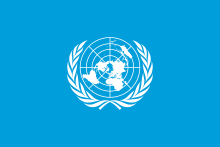
Similar flags
Please see Gallery of flags by design
Flags at sea

Flags are particularly important at sea, where they can mean the difference between life and death, and consequently where the rules and regulations for the flying of flags are strictly enforced. A national flag flown at sea is known as an ensign. A courteous, peaceable merchant ship or yacht customarily flies its ensign (in the usual ensign position), together with the flag of whatever nation it is currently visiting at the mast (known as a courtesy flag). To fly one's ensign alone in foreign waters, a foreign port or in the face of a foreign warship traditionally indicates a willingness to fight, with cannon, for the right to do so. As of 2009, this custom is still taken seriously by many naval and port authorities and is readily enforced in many parts of the world by boarding, confiscation and other civil penalties.
In some countries yacht ensigns are different from merchant ensigns in order to signal that the yacht is not carrying cargo that requires a customs declaration. Carrying commercial cargo on a boat with a yacht ensign is deemed to be smuggling in many jurisdictions.
There is a system of international maritime signal flags for numerals and letters of the alphabet. Each flag or pennant has a specific meaning when flown individually.
As well, semaphore flags can be used to communicate on an ad hoc basis from ship to ship over short distances.
Traditionally, a vessel flying under the courtesy flag of a specific nation, regardless of the vessel's country of registry, is considered to be operating under the law of her 'host' nation.
Shapes and designs


Flags are usually rectangular in shape (often in the ratio 2:3, 1:2, or 3:5), but may be of any shape or size that is practical for flying, including square, triangular, or swallow tailed. A more unusual flag shape is that of the flag of Nepal, which is in the shape of two stacked triangles. Other unusual flag shapes include the flag of Ohio and the flag of Tampa.
Many flags are dyed through and through to be inexpensive to manufacture, such that the reverse side is the mirror image of the obverse (front) side, generally the side displayed when the flag is flying from the observer's point of view from left, the side of the pole, to right. This presents two possibilities:
- If the design is symmetrical in an axis parallel to the flag pole, obverse and reverse will be identical despite the mirror-reversal, such as the Indian Flag or Canadian Flag
- If not, the obverse and reverse will present two variants of the same design, one with the hoist on the left (usually considered the obverse side, see flag illustrations), the other with the hoist on the right (usually considered the reverse side of the flag). This is very common and usually not disturbing if there is no text in the design. See also US reverse side flag.
Some complex flag designs are not intended for through and through implementation, requiring separate obverse and reverse sides if made correctly. In these cases there is a design element (usually text) which is not symmetric and should be read in the same direction, regardless of whether the hoist is to the viewer's left or right. These cases can be divided into two types:
- The same (asymmetric) design may be duplicated on both sides. Such flags can be manufactured by creating two identical through and through flags and then sewing them back to back, though this can affect the resulting combination's responsiveness to the wind. Depictions of such flags may be marked with the symbol
 , indicating the reverse is congruent to (rather than a mirror image of) the obverse.
, indicating the reverse is congruent to (rather than a mirror image of) the obverse. - Rarely, the reverse design may differ, in whole or in part, from that of the obverse. Examples of flags whose reverse differs from the obverse include the flag of Paraguay, the flag of Oregon, and the historical flag of the Soviet Union. Depictions of such flags may be marked with the symbol
 .
.
Common designs on flags include crosses, stripes, and divisions of the surface, or field, into bands or quarters—patterns and principles mainly derived from heraldry. A heraldic coat of arms may also be flown as a banner of arms, as is done on both the state flag of Maryland and the flag of Kiribati.
The de jure flag of Libya under Muammar Gaddafi, which consisted of a rectangular field of green, was for a long period the only national flag using a single color and no design or insignia. However, other historical states have also used flags without designs or insignia, such as the Soviet Republic of Hungary, whose flag was a plain field of red.
Colors are normally described with common names, such as "red", but may be further specified using colorimetry.
Vertical flags
Vertical flags are sometimes used in lieu of the standard horizontal flag in central and eastern Europe, particularly in the German-speaking countries. This practice came about because the relatively brisk wind needed to display horizontal flags is not common in these countries.[4]

The standard horizontal flag (no. 1 in the preceding illustration) is nonetheless the form most often used even in these countries.[5]
The vertical flag (German: Hochformatflagge or Knatterflagge; no. 2) is a vertical form of the standard flag. The flag's design may remain unchanged (No. 2a) or it may change, e.g. by changing horizontal stripes to vertical ones (no. 2b). If the flag carries an emblem, it may remain centered or may be shifted slightly upwards.[4][6]
The vertical flag for hoisting from a beam (German: Auslegerflagge or Galgenflagge; no. 3) is additionally attached to a horizontal beam, ensuring that it is fully displayed even if there is no wind.[4][7]
The vertical flag for hoisting from a horizontal pole (German: Hängeflagge; no. 4) is hoisted from a horizontal pole, normally attached to a building. The topmost stripe on the horizontal version of the flag faces away from the building.[4][8]
The vertical flag for hoisting from a crossbar or banner (German: Bannerflagge; no. 5) is firmly attached to a horizontal crossbar from which it is hoisted, either by a vertical pole (no. 5a) or a horizontal one (no. 5b). The topmost stripe on the horizontal version of the flag normally faces to the left.[4][9]
Religious flags

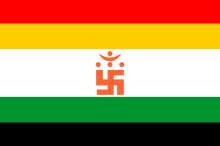

Flags can play many different roles in religion. In Buddhism, prayer flags are used, usually in sets of five differently colored flags. Many national flags and other flags include religious symbols such as the cross, the crescent, or a reference to a patron saint. Flags are also adopted by religious groups and flags such as the Jain flag and the Christian flag are used to represent a whole religion.
Linguistic flags
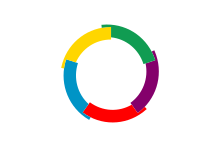


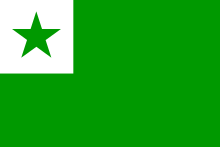
As languages rarely have a flag designed to represent them,[10] it is a common but unofficial practice to use national flags to identify them. Examples of this use include:
- representing language skills of an individual, like a staff member of a company
- displaying available languages on a multilingual website or software.
Though this can be done in an uncontroversial manner in some cases, this can easily lead to some problems for certain languages:
- languages generating language dispute, such as Romanian and Moldavian which some consider two different languages; and
- languages spoken in more than one country, such as English, Arabic, French, German, Mandarin, Portuguese, Russian or Spanish.
In this second case, common solutions include symbolising these languages by:
- the flag of the country where the language originated
- the flag of the country having the largest number of native speakers
- a mixed flag of the both (when this is not the same)
- the flag of the country most identified with that language in a specific region (e.g. Portuguese Language: Flag of Portugal in Europe and Flag of Brazil in South America)
Thus, on the Internet, it is most common to see the English language associated to the flag of the United Kingdom, but sometimes to the flag of England, the flag of the United States or a US-UK mixed flag, usually divided diagonally.
In sports
Because of their ease of signalling and identification, flags are often used in sports.
- In association football, linesmen carry small flags along the touch lines. They use the flags to indicate to the referee potential infringements of the laws, or who is entitled to possession of the ball that has gone out of the field of play, or, most famously, raising the flag to indicate an offside offence. Officials called touch judges use flags for similar purposes in both codes of rugby.
- In American and Canadian football, referees use penalty flags to indicate that a foul has been committed in game play. The phrase used for such an indication is flag on the play. The flag itself is a small, weighted handkerchief, tossed on the field at the approximate point of the infraction; the intent is usually to sort out the details after the current play from scrimmage has concluded. In American football, the flag is usually yellow; in Canadian football, it is usually orange. In the National Football League, coaches also use red challenge flags to indicate that they wish to contest a ruling on the field.
- In yacht racing, flags are used to communicate information from the race committee boat to the racers. Different flags hoisted from the committee boat may communicate a false start, changes in the course, a cancelled race, or other important information. Racing boats themselves may also use flags to symbolize a protest or distress. The flags are often part of the nautical alphabetic system of International maritime signal flags, in which 26 different flags designate the 26 letters of the Latin alphabet.

- In auto and motorcycle racing, racing flags are used to communicate with drivers. Most famously, a checkered flag of black and white squares indicates the end of the race, and victory for the leader. A yellow flag is used to indicate caution requiring slow speed and a red flag requires racers to stop immediately. A black flag is used to indicate penalties.
- In addition, fans of almost all sports wave flags in the stands to indicate their support for the participants. Many sports teams have their own flags, and, in individual sports, fans will indicate their support for a player by waving the flag of his or her home country.
- Capture the flag is a popular children's sport.
- In Gaelic football and Hurling a green flag is used to indicate a goal while a white flag is used to indicate a point
- In Australian rules football, the goal umpire will wave two flags to indicate a goal (worth six points) and a single flag to indicate a behind (worth one point).
- For safety, dive flags indicate the locations of underwater scuba divers or that diving operations are being coducted in the vicinity.
- In water sports such as Wakeboarding and Water-Skiing, an orange flag is held in between runs to indicate someone is in the water.
- In golf, the hole is marked with a flag. The flagpole is designed to fit centered within the base of the hole and is removable. Many courses will use color-coded flags to determine a hole location at the front, middle or rear of the green. However color-coded flags are not used in the professional tours.
- Flag poles with flags of all shapes and sizes are used by marching bands, drum corps, and winter guard teams use flags as a method of visual enhancement in performances.
In politics

Social and political movements have adopted flags, to increase their visibility and as a unifying symbol.
The socialist movement uses red flags to represent their cause. The anarchist movement has a variety of different flags, but the primary flag associated with them is the black flag. In the 1970s, the rainbow flag was adopted as a symbol of the LGBT social movements. Bisexual and transgender pride flags were later designed, in an attempt to emulate the rainbow flag's success.
Some of these political flags have become national flags, such as the red flag of the Soviet Union and national socialist banners for Nazi Germany. The present Flag of Portugal is based on what had been the political flag of the Portuguese Republican Party previous to the 5 October 1910 revolution which brought this party to power.
Vehicle flags
Flags are often representative of an individual's affinity or allegiance to a country, team or business and can be presented in various ways. A popular trend that has surfaced revolves around the idea of the 'mobile' flag in which an individual displays their particular flag of choice on their vehicle. These items are commonly referred to as car flags and are usually manufactured from high strength polyester material and are attached to a vehicle via a polypropylene pole and clip window attachment.
Swimming flags
In Australia, Canada, New Zealand, Philippines, and the United Kingdom a pair of red/yellow flags is used to mark the limits of the bathing area on a beach, usually guarded by surf lifesavers. If the beach is closed, the poles of the flags are crossed. The flags are colored with a red triangle and a yellow triangle making a rectangular flag, or a red rectangle over a yellow rectangle. On many Australian beaches there is a slight variation with beach condition signaling. A red flag signifies a closed beach (or, in the UK, some other danger), yellow signifies strong current or difficult swimming conditions, and green represents a beach safe for general swimming. In Ireland, a red and yellow flag indicates that it is safe to swim; a red flag that it is unsafe; and no flag indicates that there are no lifeguards on duty. Blue flags may also be used away from the yellow-red lifesaver area to designate a zone for surfboarding and other small, non-motorised watercraft.
Reasons for closing the beach include:
- dangerous rip
- hurricane warning
- no lifeguards in attendance
- overpolluted water
- sharks
- tsunami
- waves too strong
A surf flag exists, divided into four quadrants. The top left and bottom right quadrants are black, and the remaining area is white.
Signal flag "India" (a black circle on a yellow square) is frequently used to denote a "blackball" zone where surfboards cannot be used but other water activities are permitted.
Railway flags
Railways use a number of colored flags. When used as wayside signals they usually use the following meanings (exact meanings are set by the individual railroad company):
- red = stop
- yellow = proceed with care
- green or white = proceed.
- a flag of any color waved vigorously means stop
- a blue flag on the side of a locomotive means that it should not be moved because someone is working on it (or on the train attached to it). A blue flag on a track means that nothing on that track should be moved. The flag can only be removed by the person or group that placed it. In the railway dominated steel industry this principle of "blue flag and tag" was extended to all operations at Bethlehem Steel, Lackawanna, NY. If a man went inside a large machine or worked on an electrical circuit for example, his blue flag and tag was sacrosanct.[11] The "Lock Out/Tag Out" practice is similar and now used in other industries to comply with safety regulations.
At night, the flags are replaced with lanterns showing the same colors.
Flags displayed on the front of a moving locomotive are an acceptable replacement for classification lights and usually have the following meanings (exact meanings are set by the individual railroad company):
- white = extra (not on the timetable)
- green = another section following
- red = last section
Additionally, a railroad brakeman will typically carry a red flag to make his or her hand signals more visible to the engineer. Railway signals are a development of railway flags.[12]
Flagpoles
A flagpole, flagstaff, or staff can be a simple support made of wood or metal. If it is taller than can be easily reached to raise the flag, a cord is used, looping around a pulley at the top of the pole with the ends tied at the bottom. The flag is fixed to one lower end of the cord, and is then raised by pulling on the other end. The cord is then tightened and tied to the pole at the bottom. The pole is usually topped by a flat plate or ball called a "truck" (originally meant to keep a wooden pole from splitting) or a finial in a more complex shape. Very high flagpoles may require more complex support structures than a simple pole, such as guy wires, or need be built as a mast.


Since 2011, the tallest free-standing flagpole in the world has been the Dushanbe Flagpole in Tajikistan,[13] with a height of 165 m (541 ft), beating the formerly record holding National Flagpole in Azerbaijan (size: 162 m; 532 ft)[14] and the North Korean flag at Kijŏng-dong (size: 160 m; 525 ft).
The tallest flagpole in the United Kingdom from 1959 until 2007 stood in Kew Gardens. It was made from a Canadian Douglas-fir tree and was 68.5 m (225 ft) in height.[15]
The largest flag regularly hoisted in the world is the Brazilian national flag flown in the Square of the Three Powers in Brasilia, the Brazilian capital. This flag is about 3380 square meters (36382 square feet)[citation needed] and has never been taken down since opening in 1960.
Design
Flagpoles can be designed in one piece with a taper (typically a steel taper or a Greek entasis taper),[16] or be made from multiple pieces to make them able to expand. In the United States, ANSI/NAAMM guide specification FP-1001-97 covers the engineering design of metal flagpoles to ensure safety.
Hoisting the flag
Hoisting the flag is the act of raising the flag on the flag pole. Raising or lowering flags, especially national flags, usually involves ceremonies and certain sets of rules, depending on the country. A flag raising squad is a group of people, usually troops, cadets, or students, that marches in and brings the flags for the flag hoisting ceremony. Flag hoisting ceremonies involving flag raising squads can be simple or elaborate, involving large numbers of squads. Elaborate flag hoisting ceremonies are usually performed on national holidays.
Flags and communication

Semaphore is a form of communication that utilizes flags. The signalling is performed by an individual using two flags (or lighted wands), the positions of the flags indicating a symbol. The person who holds the flags is known as the signalman. This form of communication is primarily used by naval signallers. This technique of signalling was adopted in the early 19th century and is still used in various forms today.
The colors of the flags can also be used to communicate. For example; a white flag means, among other things, surrender or peace, a red flag can be used as a warning signal, and a black flag can mean war, or determined to defeat enemies.
Orientation of a flag is also used for communication, though the practice is rarely used given modern communication systems. Raising a flag upside-down was indicative that the raising force controlled that particular area, but that it was in severe distress.
Flapping
When blown by the wind, flags are subject to wave-like motions that grow in amplitude along the length of the flag. This is sometimes ascribed to the flag pole giving vortex shedding, however flags that are held by lanyards also can be seen to flap.
See also
- Lists and galleries of flags
- Gallery of sovereign-state flags
- List of flag names
- Lists of flags
- Timeline of national flags
- Unofficial flags
- Notable flag-related topics
- False flag
- Flag Day
- Flag desecration
- Flag etiquette
- Flag patch
- Flag semaphore
- Flag terminology
- Flag throwing
- Pledge of Allegiance
- Standard-bearer (also enumerates various types of standards, both flag types and immobile ensigns)
- Vexillology
- Miscellaneous
- Flags of the World, an Internet-based vexillological association and resource
- Petrosomatoglyph Symbols and prehistory
- Windsock
References
- ^ Merriam-webster.com
- ^ Articles 90–94 of the UN Convention on the Law of the Sea
- ^ Rog.nmm.ac.uk
- ^ a b c d e "Flaggentypen". German Vexillological Society (Deutsche Gesellschaft für Flaggenkunde e. V., DGF). Retrieved 20 February 2012.
- ^ German Federal Ministry of the Interior: Hissflagge, accessed 20 February 2012
- ^ German Federal Ministry of the Interior: Hochformatflagge, accessed 20 February 2012
- ^ German Federal Ministry of the Interior: Auslegerflagge, accessed 20 February 2012
- ^ German Federal Ministry of the Interior: Hängeflagge, accessed 20 February 2012
- ^ German Federal Ministry of the Interior: Hängeflagge, accessed 20 February 2012
- ^ Why you should not use a flag as a symbol of language
- ^ OSHRC.gov
- ^ Calvert, J.B. (2004-07-25). "Early Railway Signals". University of Denver. Retrieved 2007-10-07.
- ^ "Wer baut den hoechsten Fahnenmast". Asia Plus. September 9, 2008.
- ^ "Flag of Azerbaijan". Telegraph.co.uk. July 3, 2008.
- ^ "Kew Gardens Flagpole". Kew.org.
- ^ "Cone Tapered vs. Venetian Entasis Tapered". Lingo Flagpoles Inc. Archived from the original on 2005-02-28.
- Australian Botany pages
- William G. Crampton; The World of Flags; Rand McNally; ISBN 0-528-83720-6 (hardcover, 1994).
- Samuel Finley Breese Morse
- Ultimate Pocket Flags of the World; Dorling Kindersley; ISBN 0-7894-2085-6; (1st American edition, hardcover, 1996).


